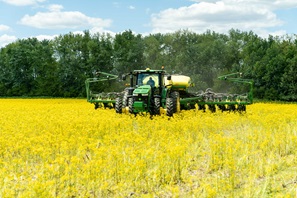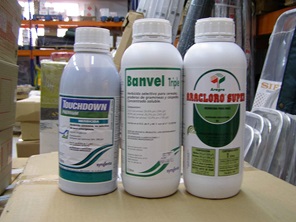This month, Genetic Literacy Project contained an article by its editor, Jon Entine, on sustainable agriculture and its relationship to the use of glyphosate. Interesting to read. With a view on new practices to develop.

Green revolution
20th century agriculture culminated in the Green Revolution, instigated by Norman Borlaug. This boosted general food production and, certainly for the time being, prevented a world-wide famine. But the Green Revolution also sparked concerns about environmental degradation, health risks, and social inequities. So far, these concerns have been dwarfed by its benefits: increasing yields together with improved soil health and water conservation. On top of this come recent advances in genetic modification (GM), that may reduce the use of herbicides, and therefore the chemical load on the environment.
The use of herbicides, together with fertilizers, was a key element of the Green Revolution. It provided the basis for a dramatic increase in food production worldwide. On the other hand, it caused environmental degradation: worse soil health, worse water quality, and less biodiversity. On top of that came the development of herbicide-resistant weed species on treated lands.

No-till farming
This sparked a re-evaluation of old agricultural practices of weed management, including no-till farming. Advantages of no-till farming are erosion control, organic matter accumulation leading to better fertility, good water efficiency and good weed control. On the other hand, erosion and soil degradation are risks, as is organic matter depletion. But on top of that, no-till farming will reduce the costs of agriculture.
The balance between these two methods was altered by the advent of glyphosate (since the mid-‘70s) and of herbicide tolerant, genetically modified (GM) varieties. The latter favoured the use of more environmentally benign herbicides. And no-till systems had better results as a result of glyphosate use, reducing erosion. However, the success of glyphosate caused overuse in many regions; and this in turn contributed to the development of weed resistance.
Advancements
A case study on the use of herbicides in sustainable agriculture in the Canadian province of Saskatchewan shows that from 1991 to 2019, a shift has taken place from environmentally harmful to more benign herbicides. The environmental impact fell considerably in this period, whereas more farmers chose for no-till farming methods, allowing for better weed control.
According to Entine, some key advancements in sustainable agriculture played a significant role in this period. Selective herbicides were developed, targeting specific weed species and reducing the need for broad-spectrum chemicals. New herbicides stay where they are applied and do not volatilize. GPS systems allow for better precision in applying the products. The products themselves break down more quickly in the environment. And other methods for control of weeds have been developed, including mechanical methods that remove weeds without the use of chemicals. In short, a more integrated method of weed control has been developed.

Chemical herbicides
This has been important in mitigating the adverse effects of modern agricultural practices. Like exposure to agrochemicals (with possible effects like respiratory diseases and reproductive disorders) and to antibiotics (with the possibility of the development of antibiotic-resistant bacteria). In many agricultural villages around the world, chemical residues threatened human health.
These were legitimate concerns in the early days of chemical herbicides. However, integrated weed management is developing, that combines various control methods and mitigates the environmental impact of sustainable agriculture. Precision agriculture will also contribute to this goal. However so far, these efforts have not yet resulted in truly sustainable agricultural practices – that will require more effort.
Glyphosate
We should keep in mind, Entine writes, that ‘the goal of sustainable agriculture is not just about increasing productivity; it’s also about ensuring the health and safety of those who produce our food and the environments in which they work.’ But, he writes, ‘there is a notable gap between public perception and scientific evidence regarding the safety of herbicides and pesticides.’ Sensational reports by media, public misunderstanding of risk and distrust in institutions play a role here.
Consider the role of glyphosate. This effective broad-spectrum herbicide has positive effects on soil health and biodiversity – whereas it reduces the need for ploughing. But it may be carcinogenic; although Entine points out that this verdict is based on limited evidence. Whereas, as he states, regulatory bodies consistently find that ‘glyphosate is unlikely to pose a carcinogenic risk to humans’ as long as it is used ‘according to approved label directions’. As grounded in ‘comprehensive reviews of extensive scientific evidence’. It is important therefore to rely ‘on the full body of scientific evidence, considering both potential risks and the context of actual use in the field.’
Herbicide resistance
Nevertheless, herbicide resistance can be a serious problem. A threat to sustainable agriculture: both global food security and agricultural sustainability. Entine points out that steps to mitigate this problem are being taken. Each of these steps will boost tolerance of herbs to a herbicide, with the consequence that less of the product will have to be used. Moreover, through crop genetics we can breed pest resistant crops, that could reduce the need for chemical herbicides – and that in turn could increase food production while reducing environmental impact. As a result of such measures, US farm output increased by 190% between 1948 and 2021, while inputs decreased. This is relevant in two respects: it reduces the environmental load, and hopefully it will slow down the development of herbicide-resistant weed varieties, so-called ‘superweeds’.
With the aid of genetic modification nowadays, we can further reduce the load of pesticides without much impact on yields. As Entine points out, ‘plant genome editing molecular tools are beginning to rewrite the debate over GM crops.’ For they ‘facilitate their development without incorporating transgenic modifications.’ We should judge such developments, he writes, with in mind ‘the unique challenges posed by climate change and global food security over the coming decades.’
Genetically modified crops
‘Genetically modified and gene-edited crops offer the potential to significantly enhance agricultural sustainability and improve food security,’ he writes. We should value such developments against the possibility of disruption of global food supply by extreme weather events, caused by climate change. Gene editing could improve abiotic stress tolerance and disease resistance, enhance nutritional quality, and boost yields. Essential in the face of climate change. But we should also ensure that poor farmers in developing countries can also access such benefits.
Entine is a proponent of intensive agricultural practices. This will conserve natural areas, because of their high productivity. Through intensive agricultural practices, we can preserve ecosystems: as a habitat for pollinators and other wildlife, as carbon sinks, and as a refuge for biodiversity, a genetic source for new crop varieties. Important for instance in case we should run into severe drought periods.
Towards sustainable agriculture
Nevertheless, we should ask ourselves what to do if herbicide resistance would continue to escalate. There are several possible solutions. First of all, innovation in herbicide development. Along this path, glyphosate might be substituted by an alternative. Gene editing and GM development could produce crops with better resistance to weeds; or better tolerance to herbicides having less impact than glyphosate. And of course, we should always try to develop sustainable agriculture with integrated weed management, a combination of mechanical, biological, and chemical control methods.
Several weed management systems are in development for sustainable agriculture. For instance, we can significantly reduce herbicide applications through the use of robotic weeders: machines that navigate through crop rows and mechanically remove weeds (or spray just a little herbicide on them). Such machines are fed with data that distinguish between the crop and the weed. Alternatively, drones or satellites may identify patches with weeds among the crop, and direct machines to remove or kill them. As a part of precision agriculture. Both more efficient and more sustainable than present practices. But again, smallholder farmers may face financial barriers to using such systems.
The road ahead
The road to sustainable agriculture will not be easy. Farmers are faced not just by economic realities, but also by the interests of environmental conservation, and health and safety concerns. We still need agricultural innovation. Both in crop genetics, and in precision agricultural practices. Many stakeholders play an important part in such an endeavour. Not just farmers – also scientists and researchers, who develop new techniques. Policymakers and regulators, who should protect public and environmental health by supporting sustainable practices. And finally the general public, who should be informed and who could support sustainable approaches. All part of the journey towards resilient, sustainable and productive agricultural systems.
Mechanical weeding brings with it the beauty of a final solution. It is effective and harmless. But a productive agriculture will be in need of many techniques. Entine writes from the conviction that nothing is wrong with genetic methods. And maybe, the balance between weed control by chemicals and by genetic protection of the crop, now gradually tips in favor of the latter. Entine is convinced of the success of new techniques like integral weed control and genetic adaptation of plants in order to render them less susceptible to poison. But these techniques are still in development. A ‘wait and see’ attitude of farmers in the face of such developments may be understandable. Hopefully, real results will appear soon.
Interesting? Then also read:
Perspectives for agriculture – the new farming
Sustainable farming: a few development pathways
Review: biostimulants for sustainable crop production
